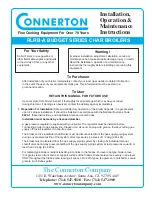
6
Valve
outlet size
Minimum
size of
discharge
pipe D1*
Minimum size of
discharge pipe D2*
from Tundish
Maximum resistance
allowed expressed as a length of
Straight pipe (no elbows or bends)
Resistance
created by
each elbow or
bend
G 1/2
15mm
22mm
28mm
35mm
Up to 9m
Up to 18m
Up to 27m
0.8m
1.0m
1.4m
G 3/4
22mm
28mm
35mm
42mm
Up to 9m
Up to18m
Up to 27m
1.0m
1.4m
1.7m
G 1
28mm
35mm
42mm
54mm
Up to 9m
Up to 18m
Up to 27m
1.4m
1.7m
2.3m
From table 1 Maximum resistance allowed for a straight length of 22mm copper discharge pipe (D2) from
a G1/2 temperature relief valve is :- 9.0m
Subtract the resistance for 4 No 22mm elbows at 0.8m each = 3.2m
Therefore the maximum permitted length equates to 5.8m
5.8 is less than the actual length of 7m therefore calculate the next largest size
Maximum resistance allowed for a straight length of 28mm pipe (D2) from a G1/2 temperature relief valve
equates to 13m
Subtract the resistance for 4 No 28mm elbows at 1m each = 4m
Therefore the maximum permitted length equates to 9m
i.e.. the actual length is 7m. A 28mm (D2) copper pipe will be satisfactory
Diagram 1. Typical discharge pipe arrangement
3.9
The discharge pipe (D1) from the vessel up to and including the tundish is generally supplied by the
manufacturer of the hot water storage system (see paragraph 3.5). Where otherwise, the installation should
include the discharge pipe(s) (D1) from the safety device(s) in either case the tundish should be vertical,
located in the same space as the invented hot water storage system and be fitted as close possible and
within 500mm of the safety device e.g.. the temperature relief valve.
The discharge pipe D2 from the tundish should terminate in a safe place where there is no risk to persons
in the vicinity of the discharge, be of metal and :-
a/
be at least one pipe size larger than the nominal outlet size of the safety device unless its total equivalent
hydraulic resistance exceeds that of a straight pipe 9m long i.e..discharge pipes between 9m and 18m
equivalent.



































